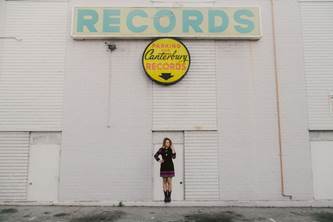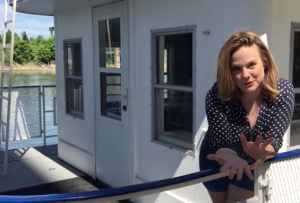My daughter, actress and singer Lenne Klingaman, is on the home stretch of a $10,000 Kickstarter campaign to fund her debut album.
It occurred to me from the moment we discussed the campaign (full disclosure: I am a co-producer), that it is similar, and radically dissimilar from a philanthropy-based campaign—so much so that I wasn’t even sure what I had to offer Lenne in this endeavor. And that was all to the good, because this was Lenne’s baby and she took full responsibility for its success or failure. The experience, still in progress with seven exciting days to go, serves to reinforce some precepts of development, and to upend others. So what were a few of these takeaways?
People give to people with a dream: So why do people give to fund other people’s passion projects? To be a part of a quest, I think. To identify and live, not vicariously, but in solidarity with people who dare to step out from conveyor-belt jobs and buck seemingly overwhelming economic odds to make something big happen in their professional or artistic lives. The product is the outcome, but the process, the journey, is almost the bigger draw. It’s a dream thing.
Confronting the odds draws support: Kickstarter has an ingenious system of requiring a goal, and if backers do not sign on in sufficient numbers, none of the credit card pledges can be redeemed. And it’s all very public. The potential for humiliation is there. There is even a Kickstarter analytics site that minces no words in its algorithmic judgments. For artists whose networks are composed of other artists, those are daunting terms. It forces people to think long and hard about their goals. It creates a real drama with nuanced developments in the early phase, the mid-campaign “flats”, and the dramatic run-up to the end, where Lenne is right now. That drama draws interest, and interest draws support.
Youth is a huge draw: As I witness the age difference between some of the larger donors and Lenne, I conclude that youth draws support. It’s a way to give something back and identify with earlier dreams and dramas of one’s life. Let’s keep in mind that for people living by their art, or working in certain types of jobs to support their art, this is real money. So backers, donors, investors—a bit of all three really—are making a difference that magnifies the impact of their gifts—and that is no small thing.
Tell a personal story, and tell it with video: It amazing what you can do with an iPhone video camera these days. Lenne composed a narrative about going to Nashville to mix the album, and took the viewer on an adventure. The story was immediate, personal, and it was a real adventure. It was palpable. Her words, her inflections, her delight, the way she talked with her hands, were all immediate, compelling “pulls” in the narrative arc. I think we too often forget in philanthropy that the immediacy, the direct authenticity, of real people talking and being is what elicits empathetic action. Not organization-speak. And maybe, in the future, video is the only way to go. Direct mail, email—they pale in comparison. But what we say and how we do it, that is the crux of the issue. We perhaps should never again need to watch a stiff executive director bore us with the benefits of the new [Fill-in-theBlank] center.
Make the benefits personal: People who give a dollar maybe get a single song download, people who give more get an autographed record…vinyl! People who give even more get their name on the CD. People who more than that, for artists who tour, like Willie Porter, who raised $60,000 on a Kickstarter campaign, enter a raffle with very impressive odds to win a house concert by the artist. The Kickstarter artist thanks many, many donors in strikingly imaginative ways.
People know they’re making a difference: Small, discrete projects with identifiable goals make everyone a hero in the end. It’s not like giving to an amorphous Annual Fund goal, or even a graduating class goal. In Kickstarter’s universe the project doesn’t happen if you don’t give. It’s that immediate and direct—it’s cause and effect. I think in development we sometimes pull out last year’s script, rewrite a few paragraphs, and say please give to the scholarship fund. There’s no real there there. There is no tangible cause and effect. Perhaps we need to sponsor particular educations. Thinking more directly about the real end effect of donations is a powerful tool, and bureaucratic exhortations are no substitute for a compelling mission—in this case a personal mission.
Kickstarter cuts out the middleman—you: Many of these projects—and they are not crowdfunded, they are funded by individuals—are exactly the type that arts, technology, or innovation grants could fund—but don’t. Those grants require a brand name and mind-numbing applications for largesse that pales in comparison with what Willie Porter raises on his own and with no red tape. These dreams people come up with are mission-based in every sense of the word. And in Kickstarter’s logic, donor fatigue doesn’t exist. People give to projects—and yes, clearly, people—in which they believe. So it’s different than philanthropy—for the love of humankind—it’s personal, giving to an actual person, or band maybe. That’s different, yes. But the fundamental pitch is: if you want to see this promising project become a reality, you have to give. And it’s true, it’s not hype. And that’s not so far from the roots of philanthropy. The fact is, it’s a quiet revolution in the quest for inspiring donors to give of themselves for initiatives that matter; and I wonder, are we paying attention, not to new principles exactly, though that is to some extent true, but to direct applications of universal principles, aided by new technology, and grounded in our deepest, direct, person-to-person social impulses?
* * *
www.kickstarter.com/projects/lenneklingaman/lenne-klingaman-the-heart-is-the-hunter

